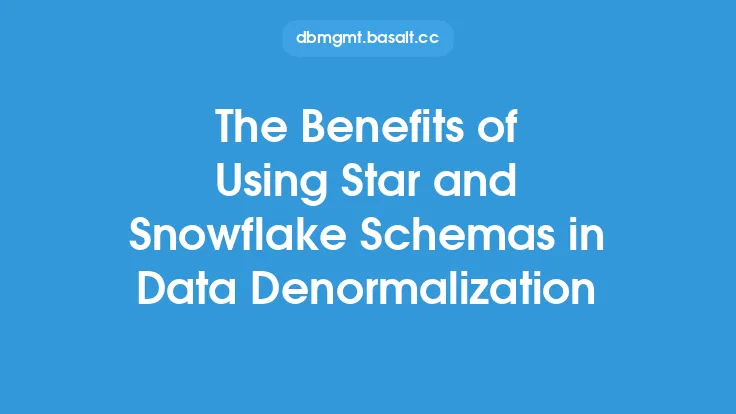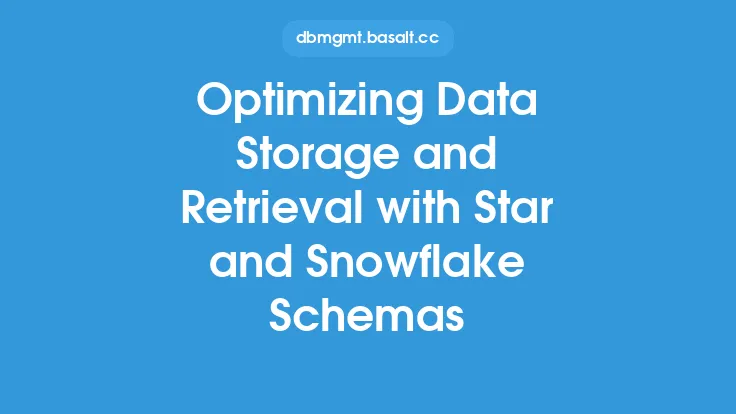In the realm of data denormalization, star and snowflake schemas have emerged as two of the most popular and effective techniques for optimizing database performance. These schemas are designed to improve query performance, reduce data redundancy, and enhance data retrieval efficiency. In this article, we will delve into the real-world applications of star and snowflake schemas in database management, exploring their uses, benefits, and implementation strategies.
Introduction to Star Schemas
Star schemas are a type of database schema that consists of a central fact table surrounded by dimension tables. The fact table contains measurable data, such as sales or website traffic, while the dimension tables provide context for the data, such as date, location, or product information. Star schemas are ideal for data warehousing and business intelligence applications, where complex queries and data analysis are common. By denormalizing data and reducing joins, star schemas can significantly improve query performance and reduce the complexity of data retrieval.
Introduction to Snowflake Schemas
Snowflake schemas, on the other hand, are an extension of star schemas, where each dimension table is further normalized into multiple related tables. This creates a more complex schema that resembles a snowflake, with each dimension table branching out into multiple sub-tables. Snowflake schemas are useful when dealing with complex data relationships or hierarchical data structures. By normalizing dimension tables, snowflake schemas can reduce data redundancy and improve data integrity, but may also increase query complexity and reduce performance.
Real-World Applications of Star Schemas
Star schemas have numerous real-world applications, particularly in industries that rely heavily on data analysis and business intelligence. Some examples include:
- Data warehousing: Star schemas are ideal for data warehousing, where large amounts of data need to be analyzed and reported on. By denormalizing data and reducing joins, star schemas can improve query performance and reduce the complexity of data retrieval.
- Business intelligence: Star schemas are commonly used in business intelligence applications, such as reporting and data visualization. By providing a simple and efficient way to access data, star schemas can enable faster and more accurate decision-making.
- E-commerce: Star schemas can be used in e-commerce applications to analyze sales data, customer behavior, and product performance. By providing a centralized repository of data, star schemas can enable more effective marketing and sales strategies.
Real-World Applications of Snowflake Schemas
Snowflake schemas also have numerous real-world applications, particularly in industries that deal with complex data relationships or hierarchical data structures. Some examples include:
- Financial services: Snowflake schemas can be used in financial services to analyze complex financial data, such as investment portfolios or risk management. By normalizing dimension tables, snowflake schemas can reduce data redundancy and improve data integrity.
- Healthcare: Snowflake schemas can be used in healthcare to analyze complex medical data, such as patient outcomes or disease diagnosis. By providing a more detailed and nuanced view of data, snowflake schemas can enable more effective treatment and care.
- Manufacturing: Snowflake schemas can be used in manufacturing to analyze complex production data, such as supply chain management or quality control. By providing a more detailed and nuanced view of data, snowflake schemas can enable more effective production planning and optimization.
Implementing Star and Snowflake Schemas
Implementing star and snowflake schemas requires careful planning and design. Some best practices for implementation include:
- Defining clear business requirements: Before designing a star or snowflake schema, it's essential to define clear business requirements and understand the needs of the organization.
- Selecting the right data: Not all data is suitable for star or snowflake schemas. It's essential to select data that is relevant, accurate, and consistent.
- Designing the schema: The schema should be designed to meet the business requirements, with a clear and consistent structure.
- Testing and validation: The schema should be thoroughly tested and validated to ensure that it meets the business requirements and performs as expected.
Challenges and Limitations
While star and snowflake schemas offer numerous benefits, they also have some challenges and limitations. Some of the common challenges include:
- Data redundancy: Star schemas can introduce data redundancy, which can lead to data inconsistencies and errors.
- Query complexity: Snowflake schemas can increase query complexity, which can lead to reduced performance and increased maintenance costs.
- Data integrity: Snowflake schemas can improve data integrity, but may also introduce additional complexity and maintenance requirements.
- Scalability: Star and snowflake schemas can be difficult to scale, particularly as the amount of data grows.
Conclusion
In conclusion, star and snowflake schemas are powerful techniques for optimizing database performance and improving data retrieval efficiency. By understanding the real-world applications, benefits, and challenges of these schemas, organizations can make informed decisions about their use and implementation. Whether it's data warehousing, business intelligence, or complex data analysis, star and snowflake schemas can provide a robust and scalable solution for meeting the needs of the organization. By following best practices for implementation and carefully considering the challenges and limitations, organizations can unlock the full potential of star and snowflake schemas and achieve significant improvements in data management and analysis.





